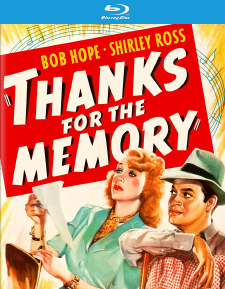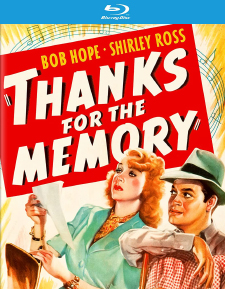Thanks for the Memory (Blu-ray Review)

Director
George ArchainbaudRelease Date(s)
1938 (March 21, 2023)Studio(s)
Paramount Pictures (Kino Lorber Studio Classics)- Film/Program Grade: B
- Video Grade: A
- Audio Grade: A-
- Extras Grade: B+
Review
Capitalizing on the popularity of the hit song Thanks for the Memory performed by Bob Hope and Shirley Ross in The Big Broadcast of 1938, Paramount quickly put into production a film of the same title that once again paired the popular co-stars. The song became Hope’s theme for the rest of his career.
In the film Thanks for the Memory, Hope plays down-on-his luck writer Steve Merrick, struggling to complete a novel. In keeping with custom of the day, he doesn’t want his wife, Anne (Ross), a former fashion model, to work, but this has led to financial problems. They owe back rent, bills are piling up, and there’s no income. Beginning to feel desperate, Anne returns to modeling and asks Steve’s publisher, Gil Morrell (Otto Kruger), for freelance work reading manuscripts. Gil happens to be Anne’s ex-fiance and still has feelings for her. Steve resents being supported by his wife. He resents having to do the housework while staying at home to complete his book. He resents Anne’s friendship with Gil.
Many of Hope’s films have paper-thin plots allowing plenty of opportunity to feature his trademark style of wisecracks and witty quips, but here he actually plays a character. There are jokes, but they don’t come at the viewer with rapid-fire speed. Hope’s typical brash line delivery is toned down considerably, making him less a vaudevillian than a real person. Lynn Starling’s screenplay takes time establishing the relationship between Steve and Anne, which is loving but threatened by his insecurity.
The chemistry between Hope and Ross is excellent and they exchange banter with a combination of affection, wit, and charm. Their characters’ financial woes drive the story, so plot developments seem reasonable rather than contrived. Anne has the ability to work and she returns to her former profession. Steve feels emasculated by having to be supported by his wife and keep house while she works. He also feels threatened by her relationship with her former fiance.
Predictably, a good deal of comedy derives from Steve’s attempts at household chores. Cooking a meal resembles a mad doctor’s lab, with lots of steaming pots, a smoking oven, and a befuddled Steve in the midst of the chaos he’s created. A cat adds to the visual gags, as does an ironing board that comes crashing down, almost beaning Hope. A beautiful southern belle from next door, Luella (Patricia Wilder), further complicates matters with her penchant for meddling in the Merricks’ lives.
In an attempt to strike musical gold once more, Hope and Ross sing the charming Hoagy Carmichael/Frank Loesser tune Two Sleepy People. After a long night of partying, Steve and Anne go out to their apartment patio, lounge on a soft couch and sing of how much they care for each other: “Two sleepy people by dawn’s early light / And too much in love to say goodnight.” The title song reappears at the end of the film, when they duet in talk/sing fashion on Thanks for the Memory with new lyrics to suit the plot. Their easy manner together conveys mutual affection tinged with irony, and the songs are pleasant touches.
Thanks for the Memory benefits from a brisk pace and excellent supporting performances by Kruger, Wilder, Roscoe Karns, and Hedda Hopper. Laura Hope Crews as Mrs. Kent, a wealthy, snooty dowager from the Margaret Dumont school of comic foils, plays the role to a tee and has a number of good lines. Eddie “Rochester” Anderson appears as a janitor who’s too sharp to fall for Steve’s fast talk and excuses when he delivers Steve’s laundered shirts and demands payment.
Thanks for the Memory was shot by director of photography Karl Struss with spherical lenses on black-and-white 35 mm film and presented in the aspect ratio of 1.37:1. Contrast is excellent with details nicely delineated. Lighting is mostly high key with romantic backlighting in scenes featuring Bob Hope and Shirley Ross. The film’s stage origins are apparent in the mostly interior sets, particularly the Merricks’ apartment. For a couple struggling with money, the apartment is remarkably spacious and even has an outdoor patio, where some of the action, including the rendition of Two Sleepy People, takes place. Ross gets to wear some elegant Edith Head-designed gowns when her character returns to fashion modeling. Hope looks harried and bewildered as his character tries to do basic housework. The few outdoor scenes are sets on the Paramount lot standing in for city streets. When Steve and Anne ride in a taxi, rear projection is used to suggest that the cab is in motion.
The soundtrack is English 2.0 Mono DTS-HD Master Audio. English SDH subtitles are an available option. Dialogue is clear and distinct, with ambient sound well mixed so that the actors’ lines are never obscured. The two musical numbers are pleasant touches, with Two Sleepy People given a laid-back, gentle presentation to coordinate with the song’s lyrics. The Thanks for the Memory reprise has new lyrics that serve as a sweet finale to the story of Steve and Anne. In the scene in which Steve attempts to cook a meal, sound effects amplify his plight, with bubbling pots overflowing, clattering mixing bowls, and drippy cake batter conspiring against him to comic effect.
Bonus materials on the Region A Blu-ray release from Kino Lorber Studio Classics include the following:
- Audio Commentary by Michael Schlesinger
- Trailer (2:07)
- Never Say Die Trailer (:55)
- The Cat and the Canary Trailer (3:40)
- Road to Singapore Trailer (2:38)
- The Ghost Breakers Trailer (2:15)
- Road to Zanzibar Trailer (2:16)
- Caught in the Draft Trailer (2:21)
- Nothing but the Truth (2:02)
- My Favorite Blonde Trailer (2:17)
- Road to Morocco Trailer (2:13)
- Road to Utopia Trailer (2:15)
- Where There’s Life Trailer (1:57)
- The Paleface Trailer (1:50)
- Sorrowful Jones Trailer (2:19)
- Fancy Pants Trailer (2:13)
- Alias Jesse James Trailer (2:13)
- Kino Lorber Studio Classics Bob Hope Promo (4:18)
We’re informed in the commentary by filmmaker/historian Michael Schlesinger that Thanks for the Memory was Bob Hope’s third film. His first two films were The Big Broadcast of 1938 and College Swing, but he wasn’t the star. For this film, Hope didn’t feel confident enough to bring over writers from his radio show to punch up the jokes. His screen persona was not fully formed until his seventh film, The Cat and the Canary, which featured him as a brash talker but a sniveling coward at heart. Shirley Ross started singing with Gus Arnheim’s band and sang The Bad in Every Man, an early version of Blue Moon, in the film Manhattan Melodrama. She was offered the role of Adelaide in the Broadway production of Guys and Dolls but was retired by then and wasn’t interested. Thanks for the Memory is based on a stage play from 1930, which was made into the film Up Pops the Devil a year later. Thanks for the Memory is the second screen adaptation, geared to Hope’s talents. The title song, originally introduced in The Big Broadcast of 1938, became a hit and an enduring standard. It also became Hope’s signature theme. The song was written by Ralph Rainger and Leo Robin, who also wrote Love in Bloom, which became Jack Benny’s signature theme. Overviews of supporting cast members, including Otto Kruger, Hedda Hopper, Eddie “Rochester” Anderson, and Patricia Wilder are provided. Kruger made his Broadway debut in 1915 and became a matinee idol. His appeared in character roles in High Noon, Hitchcock’s Saboteur, and Douglas Sirk’s Magnificent Obsession. Patricia Wilder met Bob Hope in vaudeville and made her screen debut in 1936. Thanks for the Memory was her final film. Anderson played Jack Benny’s butler for 35 years on both radio and television. He also had roles in the motion pictures Cabin in the Sky, The Green Pastures, and You Can’t Take It with You. Hopper started as a Broadway chorus girl in 1915 and became a columnist in 1935. She was known for a long-term feud with fellow gossip columnist Louella Parsons and as one of the “hatchet people” out to destroy Citizen Kane. She later appeared in movies and TV shows as herself, wearing her elaborate hats, a signature embellishment.
Thanks for the Memory is a breezy, lightweight comedy that shows off Bob Hope’s talents and focuses on his ability to inhabit a character, not merely spout one gag after another, a style that wears thin in other Hope films of the period. He has an excellent co-star in Shirley Ross, and a supporting cast of veteran character actors join forces to make financial woes and male insecurity the basis of a sharp comedy.
- Dennis Seuling

